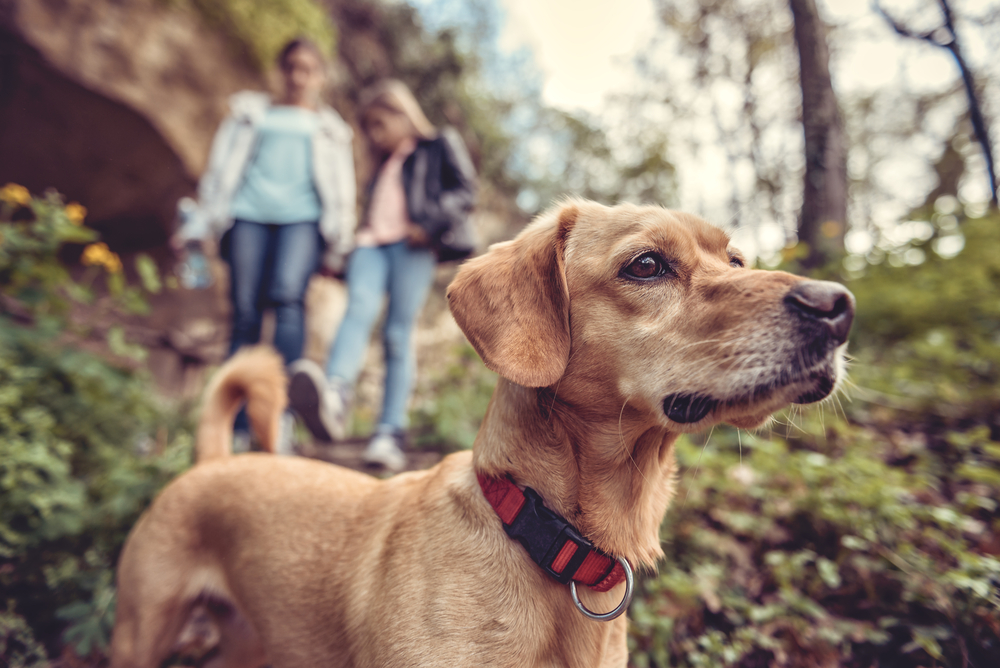As far as your dog is concerned, hiking with you is like going on a walk — only 100 times better. Although you might be the only one taking in the scenery, your dog is taking in beauty of another kind, i.e., all the different scents he doesn’t get to smell on your leisurely stroll around the neighborhood.
It takes more effort to prepare for a hike, no doubt. In addition to all your gear, it’s important to make sure your dog is equipped, too. So, along with his hiking booties, water supply, harness and leash, and poo bags, don’t forget to pack first-aid items for him. With a little planning, you can put together a comprehensive first-aid kit that has the essentials you both need should any accidents happen on the trail.

Basic elements
If you do a lot of hiking, you probably carry a first-aid kit in your backpack with some basic items. If your kit doesn’t already, make sure it includes the following items to use in a canine emergency.
- Alcohol wipes. Use these to clean and disinfect any minor cuts, scrapes, or burns, just as you would on yourself.
- Tweezers. These are effective for removing cactus spines from your dog’s paws as well as insect stingers and ticks.
- Benadryl. Administer 1 milligram per pound of bodyweight if your dog has an allergic reaction to something he encounters on the trail, like a sting from an insect or a snakebite. (If he starts having difficulty breathing, begins to vomit, or has diarrhea, seek medical attention for him immediately.)
- Gauze pads. Use these with vet medical tape to wrap an injured paw pad or limb, especially if there is an open wound.
- Vet medical tape. This tape sticks to itself but not your dog’s hair or skin. Because it’s self-adherent and flexible, it’s great for wrapping a sprained or injured limb.
- Anti-bacterial pain-relieving ointment. Just as with humans, it’s not uncommon for dogs to get a few cuts and scrapes while hiking in rough terrain. Use the same ointment you would use on any abrasions your dog receives, after cleaning and before you apply the gauze and vet tape.
What else to pack
If you’re planning a longer hike or simply want to be prepared for everything, consider packing these additional items in your supplies:
- Bandana. Wet this with water to use as a cooling rag if your dog overheats or as a muzzle if his injuries cause him to become frightened enough to bite.
- Emergency carry harness. If your dog isn’t small enough to carry in your arms, consider adding an emergency carry harness to your supplies. The straps on these slings slip over your shoulders so you can carry your dog like a backpack.
- Veterinary-approved nonsteroidal anti-inflammatory drugs (NSAIDs). Regular over-the-counter pain medication isn’t suitable for dogs, so ask your veterinarian what type of canine NSAIDs she recommends for your kit. These are effective in reducing pain and swelling.
- Saline eyewash. This is effective to have on hand if your dog happens to get sprayed by a skunk or the wind blows dirt or debris into his eye. It works for human eyes, too.
- Styptic pencil. A badly broken nail can bleed a lot. Be prepared. The powder will sting when it first hits the injured blood vessels, so hold your dog’s paw firmly when applying.
Before you hit the trail …
If this is the first time you’re taking your dog on the trail, remember: Dogs are obedient, eager animals who can’t tell you when they’ve had enough fun, so start slowly. Begin with short, easy hikes so you can gauge how your dog handles uneven terrain. Be mindful of the temperature and choose the coolest times of the day, especially during the heat of the summer months. Watch closely for signs of distress, including exhaustion or overheating. Monitor your dog for a few hours after your first strenuous hike to see how long it takes him to recover.
With a little patience, your new hiking buddy will be conditioned for this activity in no time, and you’ll have a companion that’s eager to accompany you at a moment’s notice. Hiking is good for our bodies, our minds, and our moods. Adding a dog to the equation just makes it that much better.
Editors' Recommendations
- Taking your dog’s collar off at night: Safe move or safety risk?
- How hot does concrete get in the sun? The answer might shock you
- Are Starbucks Puppuccinos bad for dogs? Here’s what veterinarians have to say
- Does your dog drink a lot of water? Here’s when you should be concerned
- Is your puppy breathing fast while sleeping? Here’s when you should worry and how to help your dog




